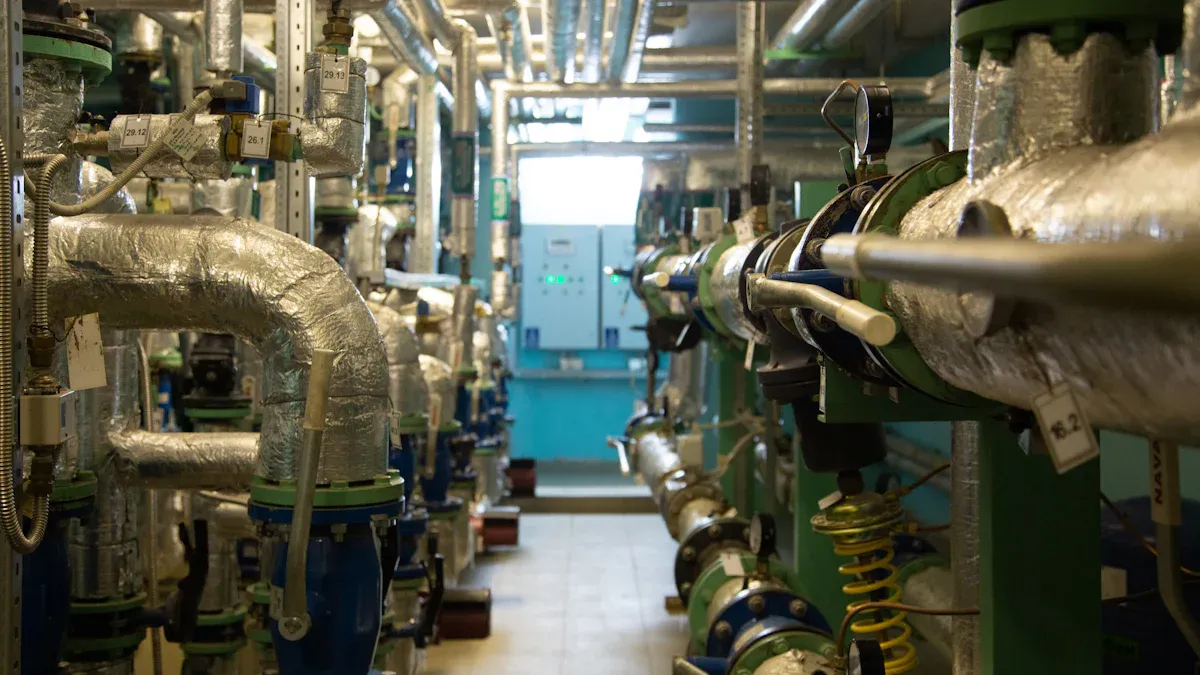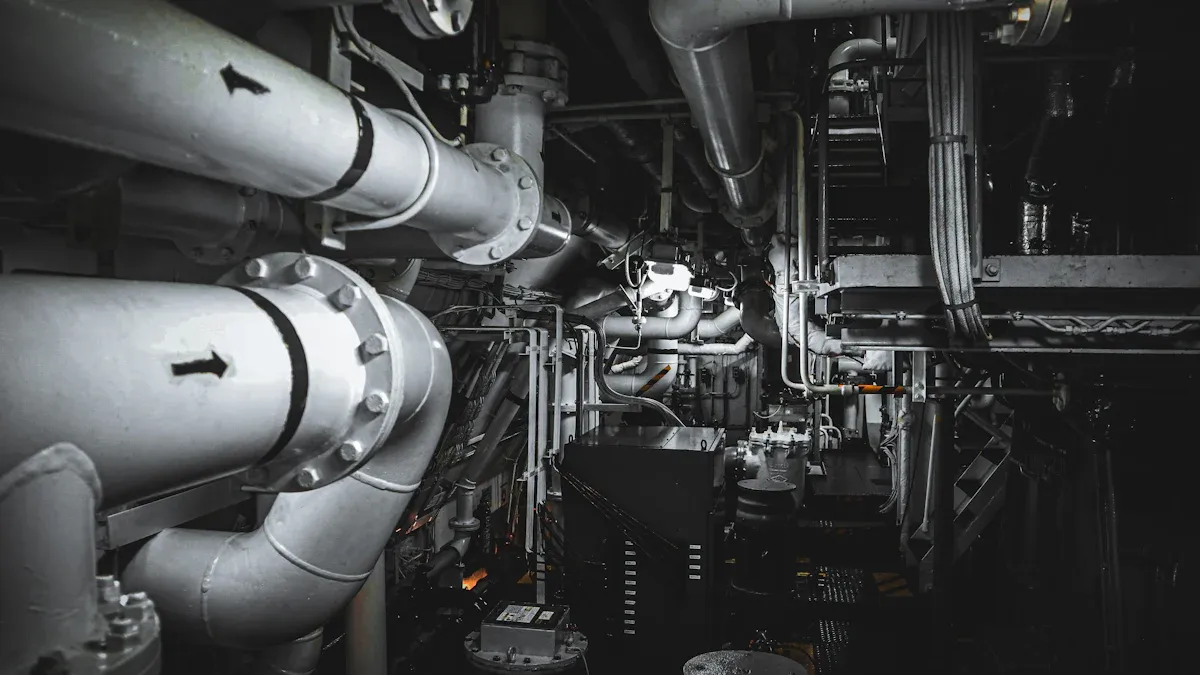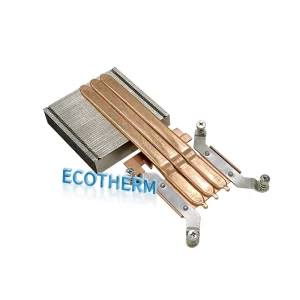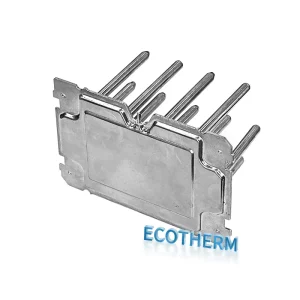What Are Vapor Chambers
You find vapor chamber cooling technology in lots of new electronics. It helps move heat fast and spread it out evenly. These are flat and thin copper heat spreaders that contain a little water or another liquid inside. Makers often use two stamped plates to build vapor chambers. Sometimes, they flatten big copper tubes to create them, which are usually 2.5 to 4 mm thick. The market for vapor chamber cooling technology is growing quickly and may reach about USD 1400 million by 2033. This indicates that good heat control is very important for the devices you use every day.
Vapor Chamber Cooling Technology Overview

What Is a Vapor Chamber
Vapor chambers are found in lots of new electronics. They help control heat well. A vapor chamber is flat and thin. It is mostly made from copper. Inside, there is a little water or another liquid. The vapor chamber has three main parts. There is a sealed shell, a wick, and the working fluid. The shell is closed tight to keep the liquid inside. The wick helps move the fluid around. The fluid and vapor stay balanced. The fluid can change when heat comes.
Tip: Copper is used most because it moves heat fast. Aluminum is used for lighter devices. Metal mesh or powder helps the fluid move inside the chamber.
You can find vapor chambers in many devices. They are in hard drives, gaming laptops, graphic cards, servers, and smartphones. Vapor chambers help keep batteries and processors cool. This is important when you play games or edit videos. Data centers use vapor chambers to spread heat. This means they do not need as many fans. Some LED lights use vapor chambers so they do not get too hot.
How Vapor Chambers Work
Vapor chamber cooling technology uses a smart way to move heat. When heat hits one side, the liquid inside turns into vapor. The vapor spreads fast across the chamber. On the cool side, the vapor turns back into liquid. The wick pulls the liquid back to the hot side. This cycle keeps going.
Here is how it works step by step:
- Heat goes into the evaporator side.
- The working fluid turns into vapor.
- Vapor spreads through the chamber.
- Vapor turns back into liquid on the cool side.
- The wick moves the liquid back using capillary action.
This process makes vapor chamber cooling technology work very well. The chamber can handle heat from 20 W to 500 W. It does not lose much performance. Some vapor chambers have thermal resistance as low as 0.029 °C/W at 200 W. This means they move heat very well.
| Material | Properties |
|---|---|
| Copper | Moves heat very well |
| Aluminum | Light and spreads heat well |
| Metal Mesh | Helps fluid move inside the chamber |
Vapor chamber cooling technology helps devices last longer. If your device stays cool, it works better and lasts more years. Vapor chambers can survive over 500,000 heating and cooling cycles. Devices with good cooling last 7 to 10 years. Poor cooling can make them last only half as long.
Note: As electronics get smaller and stronger, vapor chamber cooling technology gets more important. You will see more vapor chambers in laptops, gaming devices, electric vehicles, and data centers soon.
Types of Vapor Chambers

One-Piece and Two-Piece Designs
You can find two main vapor chamber designs. These are called one-piece and two-piece. Each design is built in a different way. Each has its own good points.
| Type | Description |
|---|---|
| Traditional (2-Piece) | Made with two plates joined together. |
| Hybrid (1-Piece) | Built from a big tube that is pressed flat. |
A traditional two-piece vapor chamber uses two metal plates. The plates are welded together to make a closed unit. This design spreads heat well in strong devices. You see two-piece vapor chambers in gaming laptops and graphics cards.
A hybrid one-piece vapor chamber starts as a big tube. The tube is pressed flat and made stronger with supports. This design can move heat better for some uses. You might find one-piece vapor chambers in top smartphones or tablets.
How each design is made changes how it spreads heat. Pick the type that fits your device best.
Ultra-Thin and 3D Variants
Ultra-thin vapor chambers help keep devices small and light. These chambers are very thin and do not take up much room. You see ultra-thin vapor chambers in new smartphones, tablets, and slim laptops. They are also used in smartwatches and game consoles.
- Ultra-thin vapor chambers give more space for batteries.
- Their light weight makes devices easy to carry.
- They spread heat well without making devices thick.
3D vapor chambers come in flat tube and round tube shapes. These work well in devices that need special cooling. Flat tube vapor chambers fit in tight spaces. Round tube vapor chambers fit in devices with more room.
Ultra-thin vapor chambers help devices stay cool and work fast. You get better battery life and strong performance. Vapor chamber cooling technology lets makers build thin products that still cool well.
If you want a small device that stays cool, choose one with an ultra-thin vapor chamber.
Vapor Chamber Cooling Technology vs Other Methods
Heat Pipes Comparison
Heat pipes are found in laptops and graphics cards. They move heat from one place to another. Vapor chamber cooling technology spreads heat in more than one direction. This helps your device stay cool in many spots.
Here is a table that shows how vapor chambers and heat pipes are different:
| Feature | Vapor Chamber | Heat Pipe |
|---|---|---|
| Thermal Conductivity | Great for even heat spreading | Good for moving heat along pipe |
| Heat Carrying Capacity | Up to 450 watts | Max about 125 watts sideways |
| Isothermality | Keeps temperature steady | Temperature changes more |
Vapor chambers keep the whole surface at a steady temperature. Heat pipes work best for moving heat from one end to another. Vapor chambers are better for cooling chips and batteries evenly.
You can also look at how they are built and used:
| Feature | Heat Pipes | Vapor Chambers |
|---|---|---|
| Structure | Sealed pipe with wick inside | Two plates sealed with vapor and wick inside |
| Heat Transfer Direction | Moves heat along the pipe | Moves heat in many directions |
| Mechanical Stress Handling | Handles strong forces well | Can be hurt by mounting, but new designs help |
| Flexibility | Can bend to fit places | Usually stiff, so harder to fit |
Tip: Vapor chamber cooling technology works better than heat pipes if you need cooling in tight spaces or want heat to move in many ways.
Metal Heat Sinks Comparison
Metal heat sinks use copper or aluminum fins to pull heat away. You see these in desktop computers and some old laptops. Vapor chambers move heat faster and spread it out better.
Here is a table that shows the difference:
| Property | Vapor Chambers | Copper Heat Sinks |
|---|---|---|
| Effective Thermal Conductivity | Over 5000 W/m°C | 401 W/m°C |
| Density | Lower than copper | Higher than vapor |
| Weight | Lighter | Heavier |
| Thermal Resistance | Lower | Higher |
Vapor chambers are lighter and fit well in thin devices. Metal heat sinks are heavier and take up more space. Vapor chambers cool slim laptops and smartphones better.
Note: Vapor chambers keep your device cool without making it big or heavy.
Water Cooling Comparison
Water cooling uses pumps and tubes to move liquid. This system works well for gaming computers and servers. Vapor chamber cooling technology gives strong cooling in a small space.
Here is a table that compares vapor chambers and water cooling:
| Feature | Vapor Chamber | Liquid Cooling |
|---|---|---|
| Efficiency | Spreads heat evenly | Gets rid of heat very well |
| Maintenance Requirements | Needs little care | Needs more work and checking |
| Design | Small, fits in tight spaces | Big, may not fit in small places |
| Response Time | Changes temperature quickly | Slower because liquid moves around |
Vapor chambers need less care and fit in small devices. Water cooling needs pumps and tubes, so it takes up more room. You need to check water cooling often to keep it working.
You can also look at cost and risk:
| Feature | Vapor Chamber Cooling | Liquid Cooling |
|---|---|---|
| Cost | Costs more to make | Usually costs less at first |
| Complexity | Needs almost no care | Needs regular care and checking |
| Size | Small, fits in tight spaces | Bigger because of extra parts |
| Risk of Failure | Very low chance of leaks | Higher chance of leaks and pump issues |
Callout: Vapor chambers give strong cooling with less risk and less work. Water cooling works well for big computers but may not fit in small devices.
You can pick vapor chamber cooling technology for slim laptops, tablets, and phones. Water cooling is best for big gaming computers and servers. Vapor chambers help you get great cooling in a small space with less worry.
Advantages and Disadvantages
Benefits of Vapor Chambers
Vapor chambers have many good points for your devices. They spread heat out, so no part gets too hot. This keeps your device safe and helps it work well. Vapor chambers can be made in many shapes and sizes. This gives you more ways to design your device. They do not need fans or moving parts. This makes your device last longer and break less. Vapor chambers are great for places that get very hot, like CPUs and GPUs.
- Spread heat out and stop overheating
- Fit many shapes and sizes of devices
- Make devices last longer with no moving parts
- Work well with lots of heat for strong performance
Here is a table that shows how vapor chambers help devices work better and last longer:
| Metric | Value | Improvement Description |
|---|---|---|
| Thermal Resistance | 0.052 °C/W | 55.8% less than copper plates |
| Operating Temperature | Below 49.4 °C | Stays cool even when used a lot |
| Wick Structure | Radial-gradient porosity | Helps vapor and liquid change faster |
You can find vapor chambers in top phones, gaming laptops, and LED lights. These devices need strong cooling to work their best.
| Device Type | Examples |
|---|---|
| High-Performance Phones | iPhone 17, High-end Android Phones |
Tip: Vapor chambers help your device stay cool, work better, and last longer.
Limitations and Considerations
There are some things to think about before picking vapor chambers. They cost more than other cooling ways. This is because they use special materials and need careful building. It can be hard to design them, since they must fit the heat source just right. Vapor chambers move heat across surfaces, but not up and down very well. If your device does not get very hot, vapor chambers may be too much.
| Limitation | Description |
|---|---|
| Higher Costs | Special materials and building make them cost more |
| Design and Integration Challenges | Must fit the heat source exactly |
| Limited Z-Direction Heat Transfer | Best for spreading heat on flat surfaces |
| Over-Engineering for Low Demand | Too complex for simple devices |
| Factor | Impact on Adoption |
|---|---|
| Cost | High price means only some devices use them |
| Manufacturing Complexity | Hard to build, so not used everywhere |
Note: Vapor chambers are best for devices that get very hot and have little space. Make sure your device needs this kind of cooling before you choose it.
You have learned how vapor chamber cooling technology keeps devices cool. This system uses phase change to control heat. It can make cooling work up to 30% better. You see vapor chambers in many new electronics. They spread heat evenly and fit in thin designs.
- Vapor chambers work well and have low thermal resistance.
- Devices are getting smaller and stronger, so cooling is more important.
- Data centers, electric vehicles, and electronics use vapor chambers for better heat control.
Think about what your device needs and how vapor chambers help before you pick a cooling solution.
FAQ
What devices use vapor chamber cooling technology?
Vapor chambers are in many electronics. You see them in smartphones and gaming laptops. They are also in graphics cards and data centers. These devices need good cooling to last longer.
How does a vapor chamber keep my device cool?
A vapor chamber spreads heat quickly. The liquid inside heats up and turns to vapor. The vapor cools down and becomes liquid again. This cycle keeps your device from getting too hot.
Can vapor chambers replace fans in electronics?
Vapor chambers do not have moving parts. Fans are still needed for very hot devices. Vapor chambers help make fans quieter and cooling better.
Are vapor chambers safe for everyday use?
Vapor chambers use sealed metal shells and safe liquids. You do not need to worry about leaks or damage in normal use.




